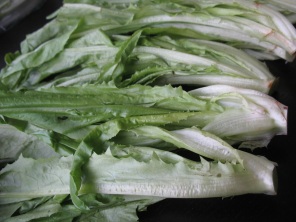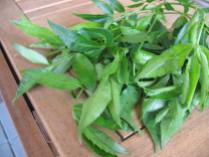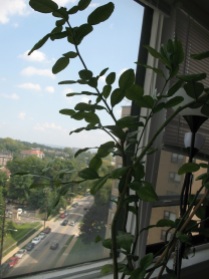This guide is by no means complete, but it will be added to over time. See here for some general information about how to navigate the vegetable section at your favorite Asian market.
For a detailed list of common Southeast Asian herbs, see my post on The Fresh Herb Section.
Indexes in English and Chinese:
| AA菜 白菜 白通菜 菠菜 菜心 潺菜 长召菜 |
葱花 大白菜 豆角 豆苗 回回苏 芥菜 |
芥兰菜 高丽菜 马齿苋 奶油菜 王帝菜 松好 |
上海菜 蒜苔 (蒜芯) 台湾白菜 茼蒿 王帝菜 西洋菜 苋菜 |
油菜 鱼腥草 召菜 绍菜 中芹 紫苏 |
AA Choy – AA菜, 油麥菜
This vegetable is commonly sold in Chinatown, and at larger markets of Washington Ave. It is sold as just the tips, or together with the stalk.
Notice the Chinese is also labeled with the latin character “A”. The name for this in Taiwan comes from an indigenous language, that sounds something like “A”. With the Cantonese word for vegetable, we get “A Choy”.
Acacia Fronds (Cha-om)
Has a funky, somewhat sulfurous odor. Popular in Thai and Lao cooking. Delicious in omelettes and Lao-style bamboo stews. Highlighted in a post on one such stew.
Amaranth leaves (En choy) 苋菜,苋菜苗
Eat it like spinach, very good lightly sauteed with garlic, oil, and a little salt.
Can be found in Chinatown on occasion, more often found at large markets of Washington Ave, also sold at North Philly’s BK market.
Bokchoy 白菜,奶油菜
Bokchoy comes in many sizes and shapes. The name simply means “White leafy vegetable” (i.e. cabbage). Some varieties have white stems, and some have green stems. Some are giant, and some are baby-sized. The Chinese name often used in Philadelphia for the white-stemmed variety is “butter vegetable” 奶油菜. See variations below Shanghai choy and Taiwan choy for more examples.
Can be found in all East Asia-focused markets, and many larger Southeast Asian markets (i.e. Washington Ave), and it can also be found at many mainstream groceries in Philadelphia (though those vegetables are much larger).
Can be eaten stir-fried, in soups, or blanched in water and served with a sauce.
Cha Plu leaves
Popular all across Southeast Asia, used most frequently for wrapping savory bites. Has a mild peppery flavor, and is highlighted in a curry soup post here.
Chile pepper leaves
See here for a post about Chile leaves.
Korean Cabbage 高丽菜
This is a variety of cabbage that comes not round, but slightly flat and often in very large sizes. Taste is very similar to round green western-style cabbage. Can be sauteed, put into soups, or eaten raw as an accompaniment.
Chinese broccoli, Chinese kale, Gailan choy 芥蓝菜, 芥兰菜,芥兰苗
This vegetable can be found in all East Asian markets, and also in many Southeast Asian markets. If it is young, it can be coarsely chopped and fried with garlic, or as a component of multi-ingredient stir fries. Use the stems too. The taste is similar to western broccoli stems (hence the name). It can also be blanched in water and served with sauce on the side. If the vegetable is older, with a tougher stalk, peel the stalk with a vegetable peeler to help it cook.
The flavor of this is slightly more concentrated than western celery, and it is a common ingredient in stir-fries.
Chinese Garlic Chives (Stems-flowers, and leaves) 韭菜 (韭菜花,韭菜)
Chinese garlic chives have a slightly pungent odor, but are great for several cooking preparations. Chive stems have a nice bite to them when fried as a vegetable, chive leaves are delicious in omelettes, and are an essential ingredient in Pad Thai.
Chinese mustard greens, gai choy 芥菜,大芥菜,小芥菜
Chinese mustard greens are a little bitter, but they can be a delicious accompaniment to savory dishes. I used them here in a classic Northern Thai soup. The image to the right is young mustard greens. These are also sold in later maturity, which are much bigger, with twisty leaves resembling a cross between lettuce and cabbage.
Choysum 菜心
Literally means “leafy vegetable heart”, and could apply to a few different vegetables. Usually it is yuchoy or Chinese mustard greens.
Chrysanthemum Leaves 松好,茼蒿, 大松好,大茼蒿
Chrysanthemum leaves are delicious in hotpot, and also in fish soups. They have a very unique flavor, and can’t be easily replaced with something else. Commonly found at East Asia-focused markets, from Chinatown to H-Mart.
Cilantro 香菜
Cilantro (aka coriander) is one of the most common herbs in cooking in Asia. Essential in Chinese and Thai cuisines. Roots and stalks are commonly used in Thai soups/curries. Most cooking preparations will require fresh leaves as the dish is finished.
Curry Leaves
Curry leaves are an important ingredient for South Indian cooking. See here for a post on one such recipe, a Kerala-style fish curry. Curry leaves are also occasionally used in Cambodian cooking.

Dill 莳萝
Dill is commonly found in mainstream groceries, and at some specialized Southeast Asian markets. It is an essential ingredient for Lao and Isaan stews, and can also be eaten raw with dips. See here for a post on a classic Lao stew with dill.
Garlic scapes (garlic stems) 蒜苔,蒜薹,蒜芯,蒜心,蒜蕊
Garlic scapes are generally available in Chinatown throughout spring. They are naturally intensely flavored and are delicious cooked in the same ways asparagus is enjoyed. See here for a dedicated post on garlic scrapes.

Green Onion 葱花
These are common in all cuisines, also known as scallions.
Hog plum leaves, or bai magauk
Popular in Southeast Asia, used most frequently raw with savory bites, or with papaya salad. This is the leaf of the sour hog plum tree. Has an interesting citrusy sour flavor.
Fenugreek leaves
Fish Mint
Holy Basil (Kapao, gapao)
This is a delicious herb that is most popularly used in Thai and Cambodian cooking. In Thailand it is used in the incredibly common chicken and basil stir fries. See here for a post on one such recipe.
Ivy Gourd Leaves
Dedicated post to this vegetable can be found here.
Kadone leaves
When this leaf is young, it is purple red and edible. It has a sour flavor.
Kaffir Lime Leaf (makrut)
This is a very common herb across Southeast Asia. The peel of the fruit is also used in making Thai curry pastes. See here for a post on one such dish, green curry chicken.
Lemon Basil (ii tuu or maenglak)
Long beans, yard-long beans, meter beans 豆角,长豆
These beans can be used raw in Southeast Asian cooking, and for stir fried dishes. I posted previously about the “four seasons” dish popular in Chinese restaurants, and also as a component of the popular Thai holy basil stir fry.
Long Napa cabbage 长召菜, 王帝菜
information yet to come.
Malabar spinach 潺菜
information yet to come.
Mint
Moringa leaves (also called Drumstick leaves)
Morning glory, water spinach, ong choy 白通菜,通心菜,空心菜, 蕹菜
Napa Cabbage 召菜,绍菜,大白菜
Pea leaf tips 豆苗
Pennywort
Purple perilla 紫苏
Also known as purple shiso, or “beefsteak” shiso. This is a type of perilla popular in Hunan Chinese cooking and Vietnamese cooking (where it is known as tía tô).
Purslane 马齿苋
Dedicated post can be found here. This vegetable can occasionally be found at the First Oriental Market on Washington Ave, and seasonally in the summer on the weekend from street sellers in Chinatown.
Rice Paddy Herb
Sawtooth Coriander (sawtooth herb, culantro, recao)

“sawtooth herb” or “sawtooth coriander”
Shanghai choy 上海白菜,白菜
Shanghai choy is a kind of bokchoy. Use it as you would a bokchoy. It comes in small and large sizes, and can be found in any East or Southeast-focused markets. The stem is greener than the other types of bokchoy.
Somach leaves
Young leaves are red to orange and are delicious served alongside savory bites or together with papaya salad. Sour flavor, similar in texture to “Vietnamese mint”.
Taiwan bokchoy 台湾白菜,白菜
Young tamarind leaves
Popular all across Southeast Asia, used most frequently for it’s sour fruit, but the young leaves can also be used as a souring agent for soups or yum-style salads.
Thai basil (horapha)
Vietnamese mint (Lady’s thumb, Vietnamese coriander, laksa leaf)
A popular herb throughout Southeast Asia, from Myanmar to Indonesia. In Vietnamese it is known as Rau răm, in Chinese 越南香菜. In Thailand and Laos the herb is called phak paew or phak fai ผักแพว/ຜັກແພວ (ผักไผ่/ຜັກໄຝ). Featured in this post on Northern Thai “soupy salad”.
Watercress can be found not only in most East Asia focused markets, but also in many mainstream grocery stores. It is great lightly sauteed with a little garlic, oil, and salt. Cut it into 2″ lengths first. These are pre-sized in small bundles. Beware that they shrink when they cook. One bundle is good for two people, as an accompaniment to another dish.
Water dropwort is a specialty item in springtime Korean cooking. I have only seen it at Philadelphia’s large Korean markets (H-Mart) or Sae Han in Blue Bell. It is a classic accompaniment to grilled pork, or it can be blanched for use as a cold side banchan. The crunchy stems are the important part.

Water mimosa, Kachet
This cruncy vegetable grows on the water, kept afloat by growths on its stalk’s skin. It needs to be cooked very briefly on high heat. Use in a similar way to Water Spinach
These can be eaten raw with spicy dips. Can be found only occasionally at specialty Southeast Asian markets (i.e. Cambodian markets of North or South Philadelphia).
Yuchoy 油菜
Yuchoy can be found in any East Asia-focused market, and many Southeast Asian markets. It is one of the most common vegetables. The literal name in Chinese is “oil vegetable”. This is because it is the plant that produces rapeseed, or canola oil. It has yellow flowers. This vegetable also comes in various sizes at the market. I like it best blanched in whole form, in boiling water and then stacked on a plate and served with a good dollop of oyster sauce.







































































































Pingback: New feature: Asian Green Vegetable Guide | Asian Markets of Philadelphia
Great resource page. Love reading about different foods/green. For me – they are a great source of energy. Are they grown locally? Do you use them in smoothies?
LikeLiked by 1 person
Hi Zipkachina, unfortunately most Asian markets don’t advertise where their produce comes from. I do happen to know at some very small shops we get some “home grown” items from time to time. Most of the big markets likely get their produce from the national “Asian Foods” distributors, with produce grown somewhere down south. No, I haven’t tried ANY of these in smoothies, but there is likely lots of exploring to do there! I use these most often just chopped up, fried with a bit of garlic and salt, and eaten with rice. Thanks for the comment! I do hope to make this better over time…
LikeLike
Wow, what an informative post. Thank you for sharing it.
LikeLike
Thank you so much for this page. Really helped me out. Most of these I find here in California, but i got something from a farmers market and the lady could not speak good english and they were crowded so i didnt find the info from her. She said soup but ive found that is the general answer i get unless they say “i’m Vietnamese and that’s a Chinese vegetable so dont know how to cook them”. Off to keep looking but this page i am hanging onto for future use.
LikeLike
Thank you very much Helen! If you have something you couldn’t find on my page, feel free to send me a picture of it. I’m familiar with more than what’s here–but I’m a little behind in my updates!
LikeLike